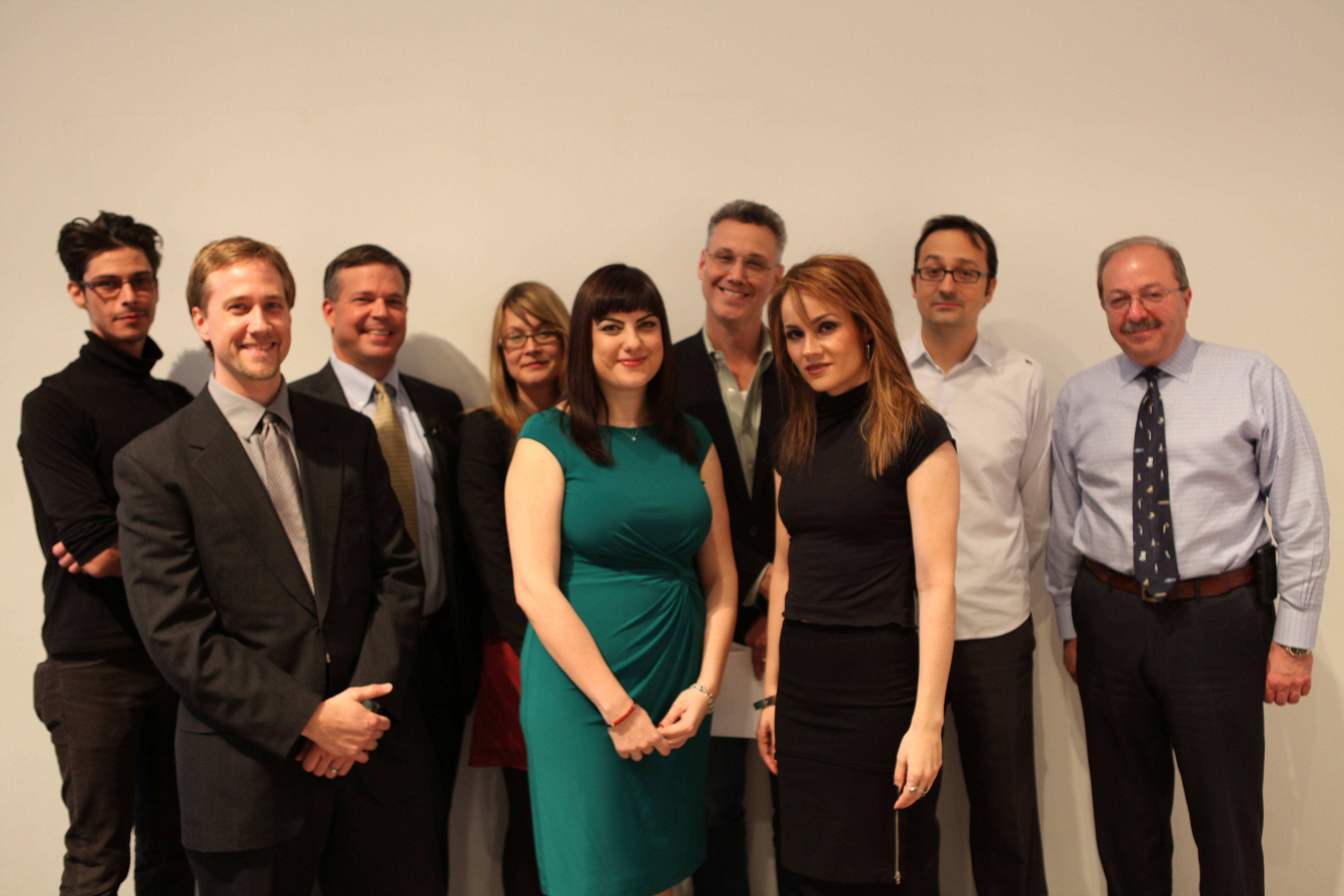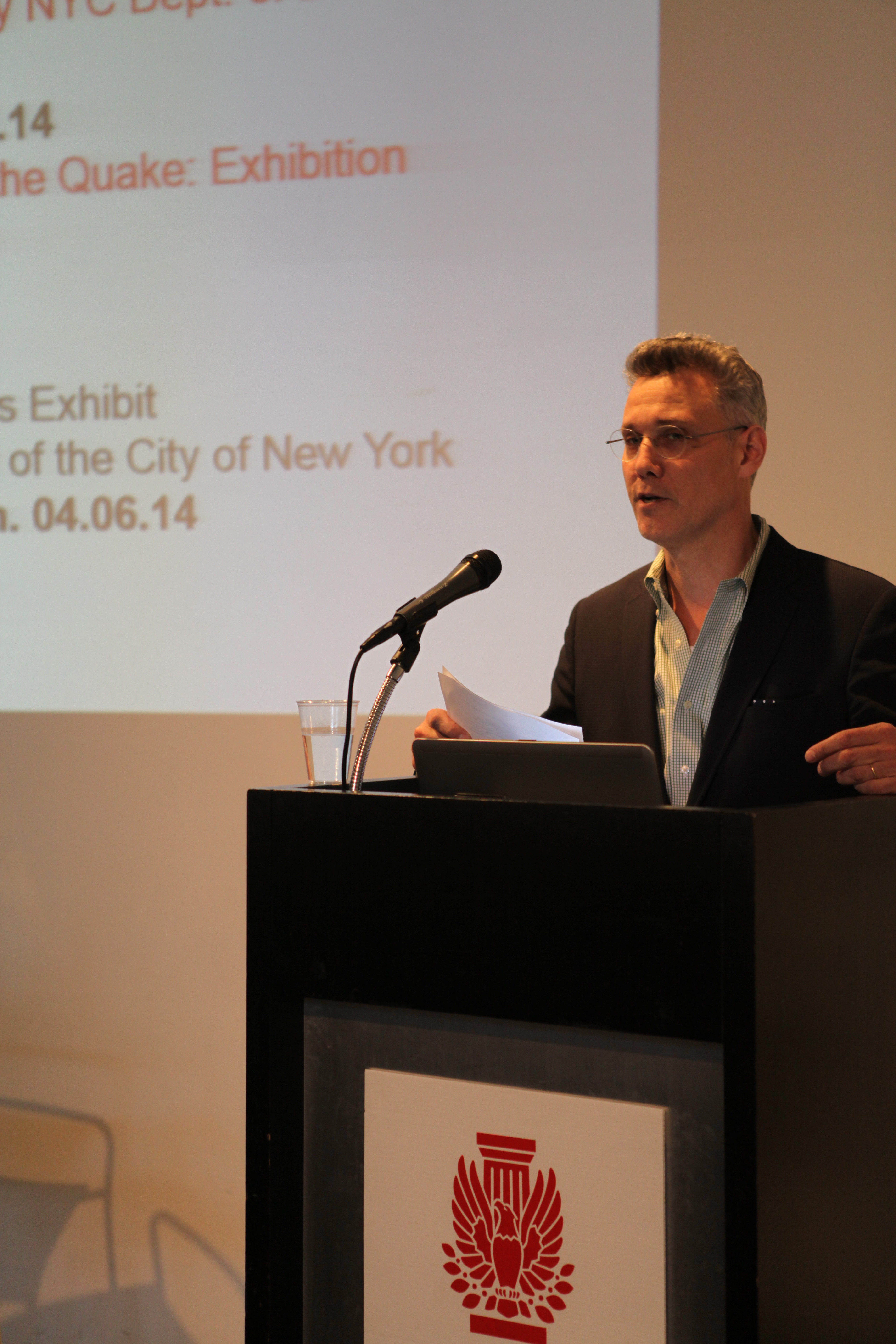by: Bill Millard
The average New Yorker probably doesn’t know there’s such a thing as the 125th Street Fault – or that in an earthquake, running out of one’s building is the wrong thing to do. (Staying inside is wiser, preferably close to something load-bearing and away from anything loose.) Yet neither earthquakes nor the technologies for dealing with them are unknown to New York, noted Giovanni Gioia, Assoc. AIA, LEED AP, of Dattner Architects, in introducing the speakers on this panel, the latest in the series accompanying the “Considering the Quake” exhibition. The chief challenge, he continued, is applying what’s known before a quake occurs, not after, as with Superstorm Sandy. A contrasting tone appeared in remarks by curator Dr. Effie Bouras, inspired by Carl Sagan’s thoughts on scientific skepticism: “We haven’t found the truth with this exhibit. Our only humble expectancy is to raise questions.” The principles of rational inquiry (gradual, partial, aware of how marginal our knowledge inevitably is) and practical applications of that knowledge (inevitably a matter of urgency) created a useful dialectic as seismic and design specialists explored strategies for preparation and mitigation.
Buildings are often surprisingly robust, Bouras observed; hazards to life come from falling objects that are not engineered against risk. Risk as a general concept bears some detailed analysis, argued Sissy Nikolaou, Ph.D., PE, of Mueser Rutledge Consulting Engineers, who noted that a Chinese ideogram for risk (危险) combines terms for danger and opportunity. New York’s building code will implement changes this October, she reported, reflecting the distinction between risk and hazard – we will be the first city in the region to adopt a risk-based rather than hazard-based model. This means that mitigation decisions are guided by risk (defined as an event’s probability multiplied by its consequences, both physical and economic, including positive rewards as well as negative effects). Hazard, in contrast, is “trying to predict nature,” inherently dicey. In the U.S., the risk of death from earthquake is about 1 in 130,000, compared with 1 in 5 for death by heart disease or 1 in 100 for car collision. Quakes have a low probability but a high impact and no notice. Codes calling for preparation against severe “2,500-year” quakes involve extrapolation from our much shorter history of magnitude-6 or 100-year quakes. Considering the uncertainties of extrapolation and the scarcity of known events, we are practically in dart-board territory, “98% sure this earthquake is not going to happen” within 50 years, since that time window equates to 2% of the 2,500-year period. New York can expect a moderate quake hazard, lower than Chile’s or Japan’s, but high population density, high-value assets, and “lack of any seismic design before 1995” add up to risks out of proportion to our hazards. All of the “three Ds” of death, damage, and downtime, Nikolaou conjectured, can be present even without structural collapse at all.
Another type of extreme event Nikolaou pointed out was the high-fatality Triangle Shirtwaist Fire of 1911, which profoundly shaped NYC building codes and labor laws, just as each California earthquake provides information from which officials update seismic codes. We are moving to the American Society of Civil Engineers (ASCE) 7-10 model, which acknowledges we cannot control the hazard but can design against risk. Mitigation of what engineers term the Maximum Considered Earthquake for Risk (MCER), in Nikolaou’s example, means setting an objective of a 1% 50-year risk of collapse, calculating the ground motion associated with that effect, and designing for life safety as the minimum target (e.g., by reinforcing soft stories such as bottom-floor garages so that they may crack but not collapse). Detailing meets higher requirements for a high-value building like a hospital or a building on soft soil, present at about 50% of New York sites. Design to minimize one type of hazard must be balanced against others: raising buildings onto pilotis against flooding leads to a soft-story risk in quakes.
Dr. Michael Constantinou, of University of Buffalo Structural Engineering & Earthquake Simulation Lab, discussed shake-table, dynamic, static, pseudodynamic, and hybrid testing procedures for structural components. The nation’s largest shake table, an outdoor facility at UC-San Diego, can hold a 2,000-ton structure for shaking with motions resembling those found in the East, or 400 tons for the stronger motions typical of California. This type of equipment can test components like concrete walls, HVAC equipment, or seismic isolators, not entire structures, and in full-scale or large-scale (up to 1:4) testing, can observe behavior that is not simulable. But the enormous loads, speeds, and costs involved require reduced-scale testing, observing physical principles of scaling and similarity; complete similarity is usually impossible. Very-small-scale (1:300) testing in wind tunnels involves more uncertainty. “The importance of failure in engineering,” Constantinou summarized, “should not be forgotten,” echoing Henry Petroski; the ongoing validation process includes retrospective studies of damage under actual quake conditions.
Daniel Lemieux, AIA, and Erik Sohn, of Wiss, Janney, Elstner, followed with a case study involving the Washington Monument, located within the closest ground-acceleration zone of the 5.8-level quake near Richmond, VA, in 2011. The monument, the world’s tallest unreinforced masonry (URM) structure, has survived several quakes, the second-largest coming in 1897 and leaving evidence of damage. The 2011 quake left spalling at the pyramidion, sheared off some mortise-and-tenon joints, cracked stone in a north-south pattern, and loosened multiple chunks of debris weighing up to 175 pounds. Repair work inside and out (conducted under time pressure, since Hurricane Irene followed the quake within a few days) involved debate between structural engineers and preservationists; the solution, adding a saddle structure and reinforcing steel to a rib and face panel in the pyramidion, preserves its world’s-tallest-URM-structure position and is not a full seismic retrofit, but the experts are confident it can withstand the forces likely to affect it in the future.
Georgi Petrov, PE, AIA, recounted SOM’s experience with supertall buildings in Asia, including the Jin Mao tower’s novel dual structural system with megacolumns and outrigger trusses around a reinforced concrete core – beyond the scope of Chinese building codes, requiring an expert-panel review process and performance-based design approval. This process has subsequently been extended to numerous structurally novel SOM towers. The analysis of a building’s force-response spectrum also considers wind loads, usually a larger concern than seismic forces, except in the new Pertamina Energy Tower in Jakarta, where the combination of relatively low wind loads and poor soil call for a largely seismically-driven design. Upper floors, particularly in slender buildings, are generally more seismically vulnerable than those below. The 1985 Mexico City quake indicated that many buildings’ upper floors collapsed even while lower sections performed well. At New York’s waterfront sites, Petrov noted, “with all these good ideas about how to build a resilient city and allow for flood, you’re solving for flood, but you’re creating a soft story in poor soil, so all these projects should have their seismic considerations checked fairly thoroughly.” Another variable is blastproofing, as in one “sensitive infrastructure project for an undisclosed location”: large spans designed for gravity, seismic, and wind loads put it far out on a response spectrum, but blast-resiliency requirements stiffened the building and reduced its vibration period, increasing its seismic loads by 55%. “Hardening your structures,” Petrov concluded, “is an iterative process.”
The city’s Office of Emergency Management, represented here by Melissa Umberger, focuses more on response, preparation, and recovery. OEM is not a lead-responder agency but a coordinating hub and public education center (it runs the now-familiar Ready New York campaign). Its Emergency Operations Center can host many multi-agency officials in a central location (see eOculus, July 10, 2007); its new Hazard Mitigation Unit plans for long-range hazard-reduction strategies, now a requirement for FEMA funding. The city’s combination of density, critical assets, no seismic design provisions in pre-1995 buildings, and infrastructural interdependencies all amplify seismic risks. Risk profiling emphasizes financial consequences, proliferating debris, and the high proportion of non-code URM buildings, though these are gradually being replaced by compliant new structures. After the 2011 Virginia quake, an Earthquake Response Playbook helps prioritize the many efforts that city officials will have to implement: transportation-disruption reactions, debris management, and interim housing (a special problem here, since FEMA post-disaster housing is low-density and unsuitable for our setting; OEM is prototyping interim housing specs as well as disseminating a residents’ safety guide).
As the discussion explored, New York’s conditions and risks are unique for multiple reasons: geology (our compressed bedrock, Nikolau noted, is the hardest found on Earth, transmitting shear waves even faster than concrete); behavioral habits (few of our neighbors recognize this risk); and the difficulties of retrofitting (infrastructural components like water mains and firehouses are an even higher priority than the URM housing stock; historically significant buildings are harder to reinforce when the structural fabric needs to be preserved as well as the appearance). Public preparedness here is an obvious challenge, but the relevant knowledge base is large and expanding. “You really don’t know if you’re prepared until you’re faced with an event,” Lemieux summarized, but “when you think of the intellectual curiosity of the group in this room… we’re asking the right questions. We don’t have all the answers, but I think we’re prepared.”
Bill Millard is a freelance writer and editor whose work has appeared in Oculus, Icon, The Architect’s Newspaper, and other publications.
Event: Earthquakes: How Well Are We Prepared?
Location: Center for Architecture, 03.24.14
Speakers: Sissy Nikolaou, Ph.D., PE, Senior Associate and Director, Geo-Seismic Department, Mueser Rutledge Consulting Engineers; Dr. Michael Constantinou, University of Buffalo Structural Engineering & Earthquake Simulation Lab (SEESL); Daniel J. Lemieux, AIA, Architect, and Erik Sohn, Senior Associate, Wiss, Janney, Elstner (WJE), Washington, DC Office; Georgi Petrov, PE, AIA, Associate, Skidmore, Owings and Merrill New York Structures Group; Melissa Umberger, Hazard Mitigation Specialist, NYC Office of Emergency Management (OEM); Dr. Effie Bouras, Postdoctoral Fellow, McGill University Department of Civil Engineering and Applied Mechanics, and Curator, “Considering the Quake” exhibition (moderator); Giovanni Gioia, Assoc. AIA, LEED AP, Project Architect, Dattner Architects, and Program Chair, DfRR (introduction)
Organizers: Center for Architecture, AIANY Design for Risk and Reconstruction Committee (DfRR), and the New York–Northeast Chapter of the Earthquake Engineering Research Institute
Sponsors: Arup (underwriter); Allegion, Lutron, Robert Silman Associates, and SOM (patrons)









